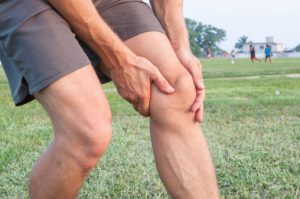
Baker’s cysts form when there is a problem with the knee joint that causes excess fluid, which forms the cyst. Treating the underlying cause of the Baker’s cyst can offer the patient relief from pain and discomfort.
This piece will outline the causes, symptoms, and natural treatment options for Baker’s cysts.
Baker’s cyst behind knee signs and symptoms
Some patient’s living with a Baker’s cyst may never experience pain or even notice that they have a cyst behind the knee, but when symptoms do arise, they may include:
- Swelling or lump behind the knee—this may be more visible when a person is standing, and the lump may feel like a fluid-filled balloon
- Pain in the knee and calf
- Accumulation of fluid around the knee
- Knee pain that may click or buckle
- A knee joint that may lock
Baker’s cyst causes, complications, and risk factors
The fluid that accumulates in a Baker’s cyst is known as synovial fluid, which is normally found in the body circulating through the cavities in the knee joint. Excess production of synovial fluid, along with the added pressure of the knee joint, causes the fluid to form a bulge behind the knee.
Common causes of Baker’s cysts include damage to the knee’s cartilage, arthritis of the knee, rheumatoid arthritis, and other knee conditions that can lead to inflammation of the joints.
Although complications are rare, they are possible and may include prolonged swelling, severe pain, and complications resulting from a knee injury, such as torn cartilage.
If the fluid bursts, the pain may become quite severe and be accompanied by swelling of the knee and the calf. The calf may also appear red and the patient may feel a sensation similar to water running down their calf.
Risk factors of a Baker’s cyst include a torn meniscus, arthritis, or an injury to the knee joint.
Treatment and diagnosis for Baker’s cyst behind knee
While examining your leg, your doctor will look for swelling along with comparing both knees to spot any differences. They may also compare range of motion between both knees to determine any discrepancies or pain that may be involved with the movement.
If the cyst is of a larger size, increases in size rapidly, or pain becomes more severe, your doctor will recommend additional testing, such as an ultrasound or MRI to determine what is causing the bulge. A cyst won’t appear on an x-ray, but your doctor may still order one to rule out other problems that can cause similar symptoms.
In many cases, a Baker’s cyst will go away on its own and does not require treatment. If it continues to grow and symptoms begin to worsen, then there are a variety of treatments that your doctor can recommend.
Fluid drainage: A needle is inserted behind the knee, and using an ultrasound to guide the needle, your doctor will carefully draw out the fluid.
Physical therapy: Regular, gentle exercises may help improve range of motion along with strengthening your muscles, which support the knee. Using crutches temporarily can help alleviate pain, along with compression wraps and ice packs.
Medication: Corticosteroid medications may be prescribed and can be administered through injections. These injections can help ease pain for some time, but do not prevent the cyst from reoccurring.
Other treatments for a Baker’s cyst may target the specific underlying cause, such as arthritis or a torn cartilage. Surgery may be suggested as a means to repair any damage to the knee along with removing the cyst.
Home remedies for a Baker’s cyst include following the RICE formula—rest, ice, compression, and elevate—taking over-the-counter pain medications, and reducing your amount of physical activity.
Although a Baker’s cyst won’t lead to long-term damage, it can be quite uncomfortable. Speaking to your doctor can help you determine which treatment option would work best for you.
Related: Knee pain at night, causes and home remedies